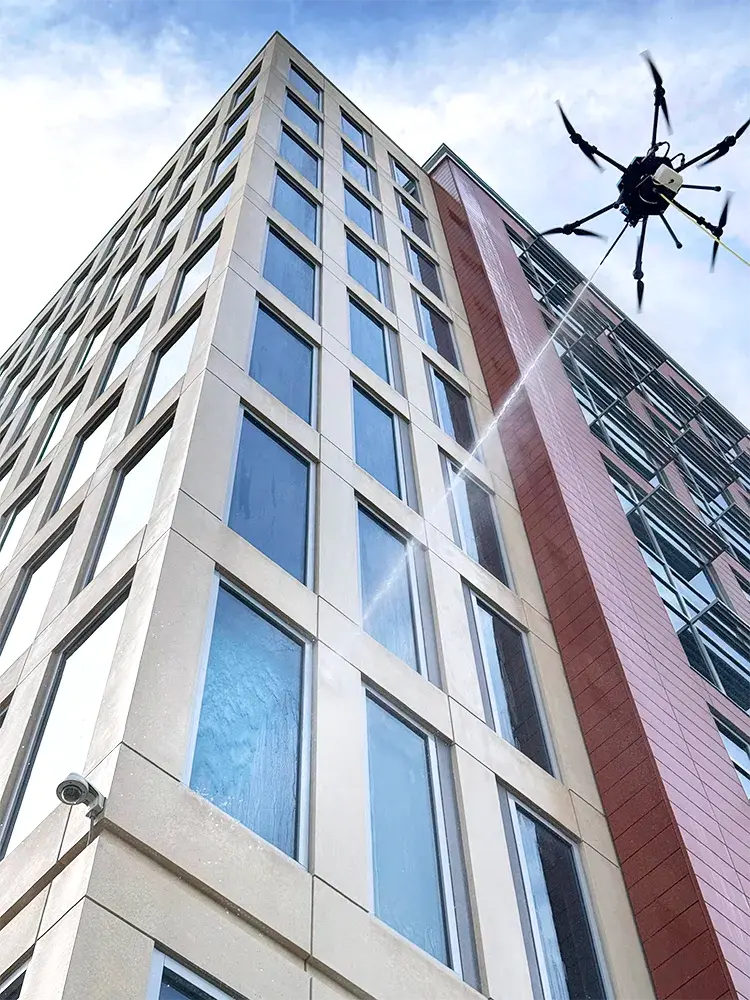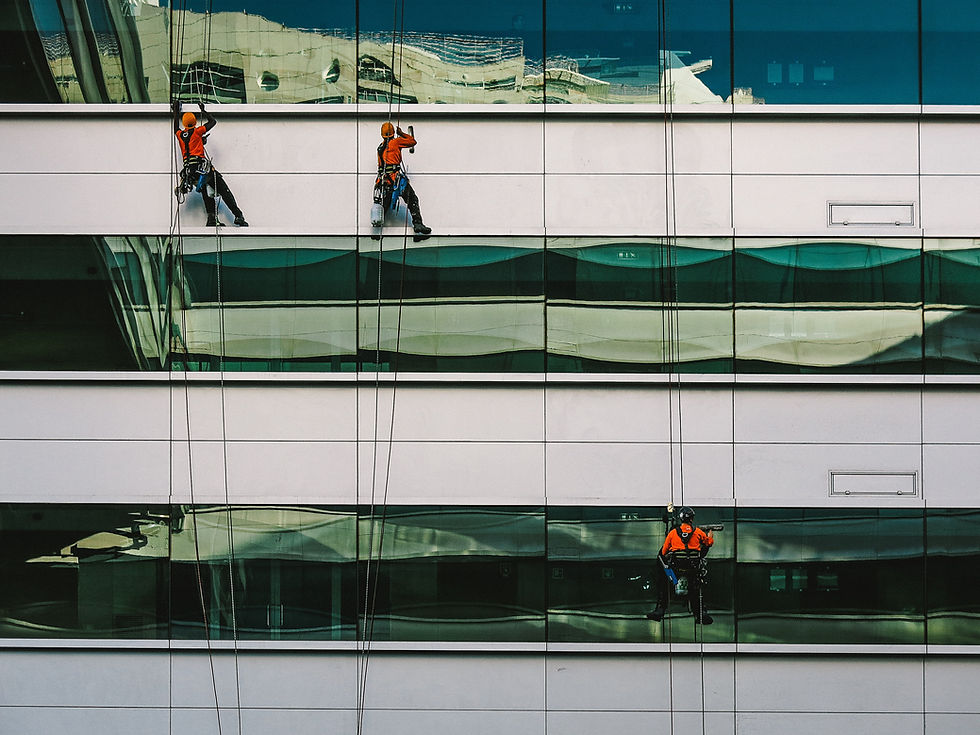OSHA & Window Cleaning Drones
- Geoffrey M Green
- May 22
- 5 min read
As of early 2018, OSHA updated requirements for rope descent systems (RDS) and scaffolding. As a result, traditional window cleaning companies have had to grapple with evolving safety regulations and rising insurance costs. Drone window cleaning has emerged as a game-changing solution. This technology not only enhances worker safety but also slashes liability risks associated with fall protection requirements.

Table of Contents
Below, we explore how drones are reshaping the industry while addressing compliance challenges head-on.
1. Current OSHA Regulations
OSHA regulates window cleaning operations through standards for rope descent systems (RDS), scaffolding, and fall protection. For traditional window cleaning on mid- and high-rise buildings, the employer must ensure that:
All workers using an RDS are fully trained and have up-to-date training records.
The building owner must provide written certification that each anchor point is capable of supporting at least 5,000 pounds in any direction per worker, with annual inspections and at least one certification every ten years.
Each worker must use a separate fall arrest system tied to a dedicated anchor, and rescue plans must be in place in case of a fall.
All RDS components (except seatboards) must support a minimum load of 5,000 pounds; seatboards must support 300 pounds.
RDS use is prohibited above 300 feet unless using an Industrial Rope Access System (IRAS), which requires advanced training and certification.
Employers must also ensure that ropes are protected from abrasion and that equipment is inspected before each use.
These regulations are designed to minimize fall hazards and ensure safe working conditions for window cleaners.
2. Window Cleaning Drones

Drone window cleaning revolutionizes safety and efficiency by removing workers entirely from dangerous heights. Operators control advanced drones from the ground using real-time video feeds, which provide clear visibility and precise navigation. Advanced drones are equipped with collision-avoidance sensors and automated flight paths, allowing them to maintain a safe distance from windows and building features, minimizing the risk of accidents and property damage.
By keeping workers grounded, drone technology helps companies avoid penalties for non-compliance with OSHA fall protection standards. This approach not only reduces workplace injuries but also simplifies regulatory compliance, as there is no need for complex rigging or scaffolding setups.
For property managers, drone window cleaning offers a modern, sustainable solution that streamlines operations and reduces environmental impact. The technology enables faster project completion, especially for high-rise and hard-to-reach building windows, and the use of purified water ensures a streak-free finish. As more organizations recognize these benefits, drone window cleaning is setting a new standard for commercial window maintenance, aligning with evolving safety and environmental best practices.
3. Traditional Method Risks

Traditional high-rise window cleaning methods, such as suspended scaffolding and rope descent systems (RDS), have long posed significant safety risks. The Occupational Safety and Health Administration (OSHA) reports that falls remain the leading cause of death, accounting for 36% of all workplace fatalities in 2023. Swing stages and RDS require workers to operate at extreme heights, often in unpredictable weather conditions, increasing the likelihood of equipment failure or human error.
Recent OSHA updates have intensified compliance demands. For example, anchor points for RDS must now withstand 5,000 pounds of force per worker - a standard that many older buildings struggle to meet without costly retrofits. Additionally, mandatory biannual inspections of rigging systems and fall arrest gear add administrative burdens. These challenges have been compounded by labor shortages, with window cleaning companies reporting difficulties hiring qualified workers, leading to rushed training and heightened accident risks
4. Property Manager Benefits
For property managers, the adoption of window cleaning drones delivers a host of advantages that go far beyond simply keeping windows sparkling clean. One of the most significant benefits is the dramatic reduction in liability and risk. Traditional window cleaning methods require workers to operate at dangerous heights, exposing them to potential falls and accidents, which in turn increases insurance premiums and those costs being included in proposals. Drones eliminate these risks by keeping workers safely on the ground, resulting in fewer workplace injuries and a notable decrease in liability concerns.
In addition to improved safety, drones offer other substantial cost savings. The need for expensive equipment like scaffolding, lifts, and harnesses is removed, as is the requirement for large crews. This reduction in labor and equipment translates directly into lower operational costs, allowing property managers to allocate resources more efficiently and even reinvest savings into other maintenance priorities. With drones, cleaning schedules can be accelerated and completed in a fraction of the time compared to traditional methods, minimizing disruption to tenants and visitors.
Another key advantage is the ability to address hard-to-reach areas that might otherwise be neglected or require specialized access. Drones can effortlessly clean windows, awnings, and architectural details on both historic and modern buildings, ensuring a consistent and thorough clean across the entire property.This level of access not only enhances curb appeal but also helps maintain property value and tenant satisfaction.
Finally, the integration of drone technology positions property managers as forward-thinking leaders in facility management. By embracing innovative solutions, managers can demonstrate a commitment to safety, efficiency, and sustainability - qualities that are increasingly valued by tenants, investors, and regulatory authorities.The result is a safer, more cost-effective, and streamlined maintenance process that benefits everyone involved.
5. Embracing The Shift
The transition to drone window cleaning isn’t just about adopting new technology - it’s about future-proofing operations against regulatory changes and escalating liability costs.
For property managers, this shift means fewer OSHA inspections, lower passed on costs, and enhanced tenant satisfaction through faster service. Property managers can also significantly reduce operational disruptions, as drones require minimal setup and can clean large areas in a fraction of the time needed by traditional methods. This efficiency enables cleaning to be scheduled during off-peak hours, further minimizing inconvenience to tenants and maintaining a professional atmosphere within the building.
Additionally, compliance with FAA Part 107 and other regulatory requirements ensures that every operation is conducted safely, legally, and with full transparency, protecting both property owners and service providers from potential fines and liability. Embracing drones demonstrates a commitment to innovation, safety, and sustainability, positioning property managers as leaders in modern facility management who are ready to meet the evolving demands of the industry.
Conclusion
The window cleaning industry is evolving rapidly as stricter OSHA regulations for rope descent systems and scaffolding increase the costs and risks of traditional methods. Drone window cleaning has emerged as a powerful solution, keeping workers safely on the ground and dramatically reducing liability for both cleaning companies and property managers. By leveraging advanced drone technology, property managers can achieve safer, faster, and more efficient window maintenance, minimize disruptions to tenants, and maintain high-quality results even on hard-to-reach building windows.
Embracing drone window cleaning is more than an operational upgrade - it’s a strategic investment in the future of facility management. Property managers who adopt this innovative approach benefit from enhanced safety, reduced liability, and a reputation for leadership in sustainability and efficiency, positioning themselves ahead in today’s competitive real estate environment.



Comments